Reducing infection risks through
effective virus protection and air filters
What are viruses?
Viruses are organic structures that spread as virus particles, known as ‘virions’, and usually have a diameter of 0.015 µm to 0.4 µm (µm = micrometer). One micrometer corresponds to a thousandth of a millimeter. Viruses are therefore very small and allocated to the PM1 category. The classification of particles into the categories PM10, PM2.5 and PM1 is based on the "National Air Quality Standard for Particulate Matter" of the US Environmental Protection Agency (EPA) and is accepted and used worldwide. This classification plays a particularly important role in air filtration, as the size of the particles to be filtered is important in mechanical filtration. The choice of right filter is decisive here.
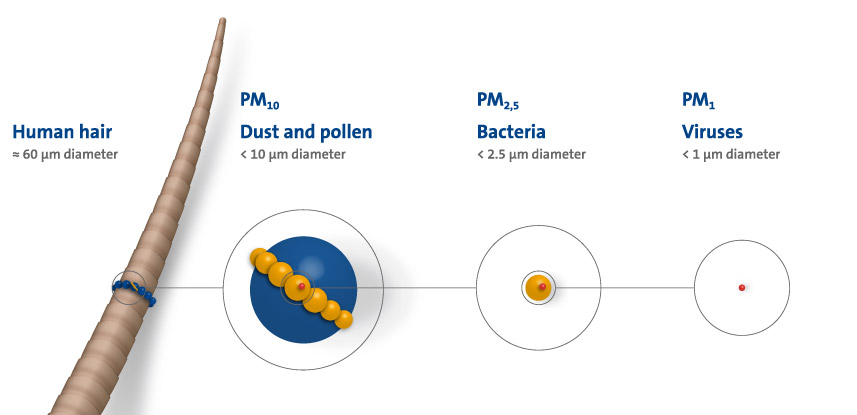
They do not themselves consist of cells and can only reproduce with the help of other cells. For this reason, they are fundamentally dependent on living organisms as hosts. Like bacteria, parasites and fungi, viruses belong to the category of pathogens and cause health-damaging conditions in their hosts.
Pathogens compared: viruses, bacteria and parasites
In contrast to viruses, bacteria are unicellular organisms and can multiply via cell division. Parasites also consist of cells. However, like viruses, they exploit the metabolic processes of a host to reproduce themselves.
Familiar viruses at a glance

Coronavirus
Transmission path: Droplet and contact infection
The Covid-19 (Corona) virus can cause diseases ranging from a normal cold to severe disease progression.
The WHO has declared the outbreak of this virus to be a health emergency of international concern.
Influenza
Transmission path: droplet and contact infection
“Standard” flu is one of the most common viral infections. The World Health Organization (WHO) estimates that between 10-20% of the world's population is affected every year.
Measles virus
Transmission path: Droplet infection
Measles is regarded as a typical childhood disease. Transmission is prevented by vaccines. Cases of infection are still widespread in Africa.
Ebola virus
Transmission path: Smear infection
Ebola can be transmitted by animals and between people. It causes the deadly Ebola fever.
Swine flu
Transmission path: Droplet and contact infection
The H1N1 virus can infect both humans and mammals. In 2009, over 500,000 people in 200 countries were infected within a matter of months.
Virus transmission and the correct protection against infections
Not all viruses are equally contagious. While some pathogens are only transmitted through intensive contact, others can be spread simply in airborne particles by physical proximity. In the case of infection paths that use air as the transmission medium, effective air filter concepts can be used to combat these pathogens. The quality of the room air and thus the air filtration have no influence on other sources of infection, such as contaminated food or water.
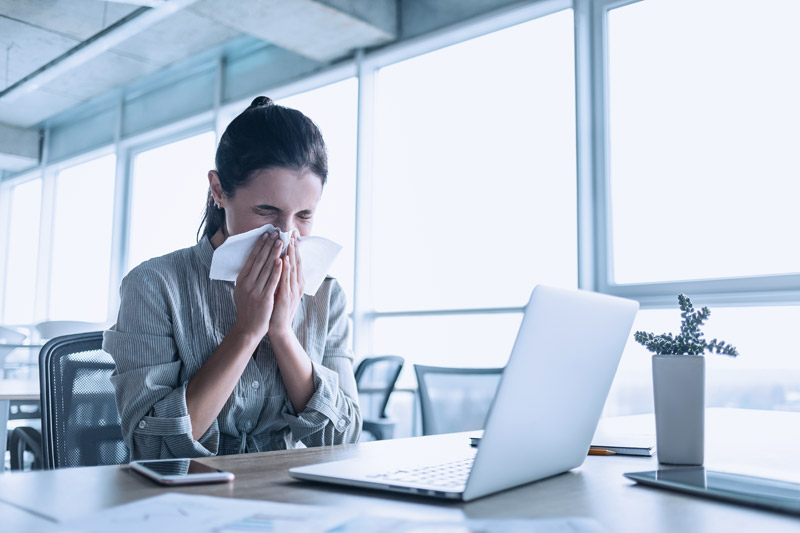
Droplet infection
Viruses that colonize the respiratory tract and mucous membranes are mainly absorbed through the ambient air. When we sneeze, cough or speak, tiny droplets containing virus particles are released into the air. The tiniest droplets are suspended in the air for a long time and are inhaled by other people. Droplets >5µm sink relatively quickly and reach objects and surfaces from where they are then indirectly spread.

Contact or smear infection
With contact and smear infections, the pathogens are transmitted by touch. Sick patients may also have viruses on the palms of their hands. If they shake hands with other people, the viruses are transmitted. Infection can also be indirectly transferred via objects such as door handles. Thorough hand washing is an effective way of preventing contact infections. Good hygiene practices support virus protection.
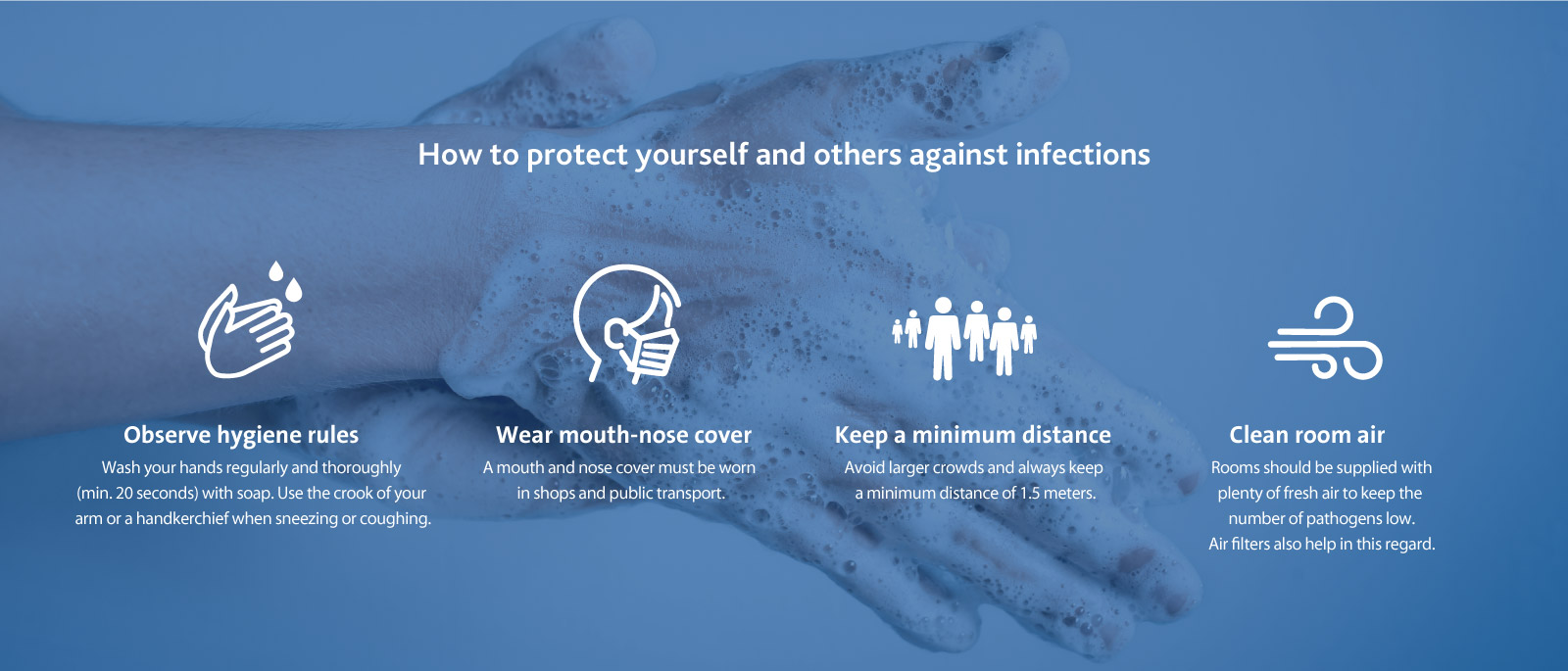
Which respiratory masks make sense and when?
In order to protect against droplet or smear infection with Covid-19, many countries require by law that respiratory protection products be worn in certain areas of life. Where this is not the case, health institutes make important recommendations for protection against an infection. However, local and legal regulations must always be taken into account.
In everyday life one encounters very different types of masks for covering mouth and nose.In recent weeks, the topic has attracted a great deal of press media attention: But Wwhich respirators offer adequate protection against viruses? What is the difference between a mouth-nose protection and a filtering half mask? Do self-sewn "DIY or community masks" protect against viruses at all? For better differentiation, please find here an overview:
| Mask type | Daily-use masks | Mouth and nose protection | Filtering half masks |
|---|---|---|---|
| Intended use | Private use | External protection | Self-protection / Industrial safety |
| Medical device | No | Yes | Yes |
| Testing and certification | No | Yes, DIN EN 14683:2019-6 Standard | Yes, DIN EN 149:2001-10 Standard |
| Protective effect | Usually not proven; by wearing the masks, the speed of the respiratory flow or saliva/mucous droplet ejection can be reduced and the masks can support the awareness of "social distancing" as well as health-related mindfulness with oneself and others | Protection against droplets of the carrier | Protection of the carrier against solid and liquid Aerosols |
This table is based on the guidelines of the German Federal Institute for Drugs and Medical Devices (BfArM) for the use of masks (available only in German language):
https://www.bfarm.de/SharedDocs/Risikoinformationen/Medizinprodukte/DE/schutzmasken.html
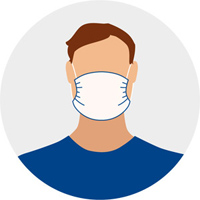
Daily-use Masks
The "daily-use masks" (also called community masks) include a large number of different masks. The spectrum ranges from DIY masks to industrially produced masks.
DIY masks are usually sewn from simple fabrics and are worn in everyday life. While shopping or even walking you will meet more and more people who wear so-called "DIY masks" (also called community or daily-use masks). Most of them are sewn from simple cotton fabrics and thereforeThey do not protect like a certified medical product and may not be sold as such. But they can help to prevent the carrier from touching his or her face as often and thus reduce the risk of a smear infection, e.g. via the hands.
Industrially produced daily-use masks that are not certified as medical devices are made of different materials. The range extends from simple fabrics to high-quality, multi-layer respiratory protection media. Consumers should therefore pay attention to the material used when buying such a mask, as this represents a significant difference in quality. Compared to simple cotton fabrics, high-quality, multi-layer polypropylene respiratory protection media can significantly reduce the release of particles into the air when speaking, sneezing or coughing. They therefore have properties comparable to those of certified mouth-nose protection.
However, all daily-use masks have one thing in common: they are not approved as medical device and do not have the CE mark. Single-use masks should be disposed of in household waste after use.
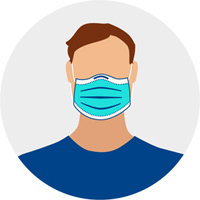
Mouth and Nose ProtectionMouth and nose protection is known, for example, from the operating theatre as a surgical mask or from a treatment at the dentist, as it is mainly used for patient protection. Although this is a certified medical device according to DIN EN 14683, it does not offer sufficient protection against an airborne infection. The mouth-nose protector is only suitable for reducing the risk of infection of other people when coughing or sneezing, if you yourself are already ill. Such a mask only protects the wearer against larger droplets. As the mouth-nose protection becomes soaked through with the duration of wearing it, it should be replaced after several hours.
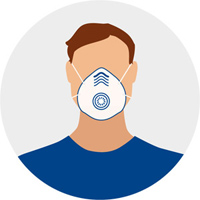
Filtering Half MasksFiltering Face Piece (FFP) half masks cover the nose and mouth and protect against respirable dust, smoke and liquid mist. They are made of rubber or silicone and are supplemented by various filter materials. The use of these masks is mandatory at workplaces that exceed the threshold limit value (TLV) of substances hazardous to health. A differentiation is made between FFP1, FFP2 and FFP3. Protective masks of the classes FFP2 and FFP3 are also recommended for hospital staff, care workers and other groups of people with an increased risk of infection. In the case of direct contact with infected individuals, tight-fitting FFP23 respiratory masks offer the an appropriatebest protection against pathogens. The filter media captures viruses and bacteria.
What standards apply to mouth and nose protection and respiratory masks?
There are different norms and standards for mouth and nose protection and respiratory masks worldwide. Here you can find an overview for better understanding:
Our technical filter information contains further details on how to protect against germs and viruses.
Solutions for industrial air filtration reduce airborne viruses
Effective protection for hazardous areas through air filters
Indoors, air filtration helps to minimize the risk of pathogens such as viruses and bacteria and to imporve the air quality. Therefore, high-quality, individually adapted air filtration systems are recommended, especially for sensitive areas.
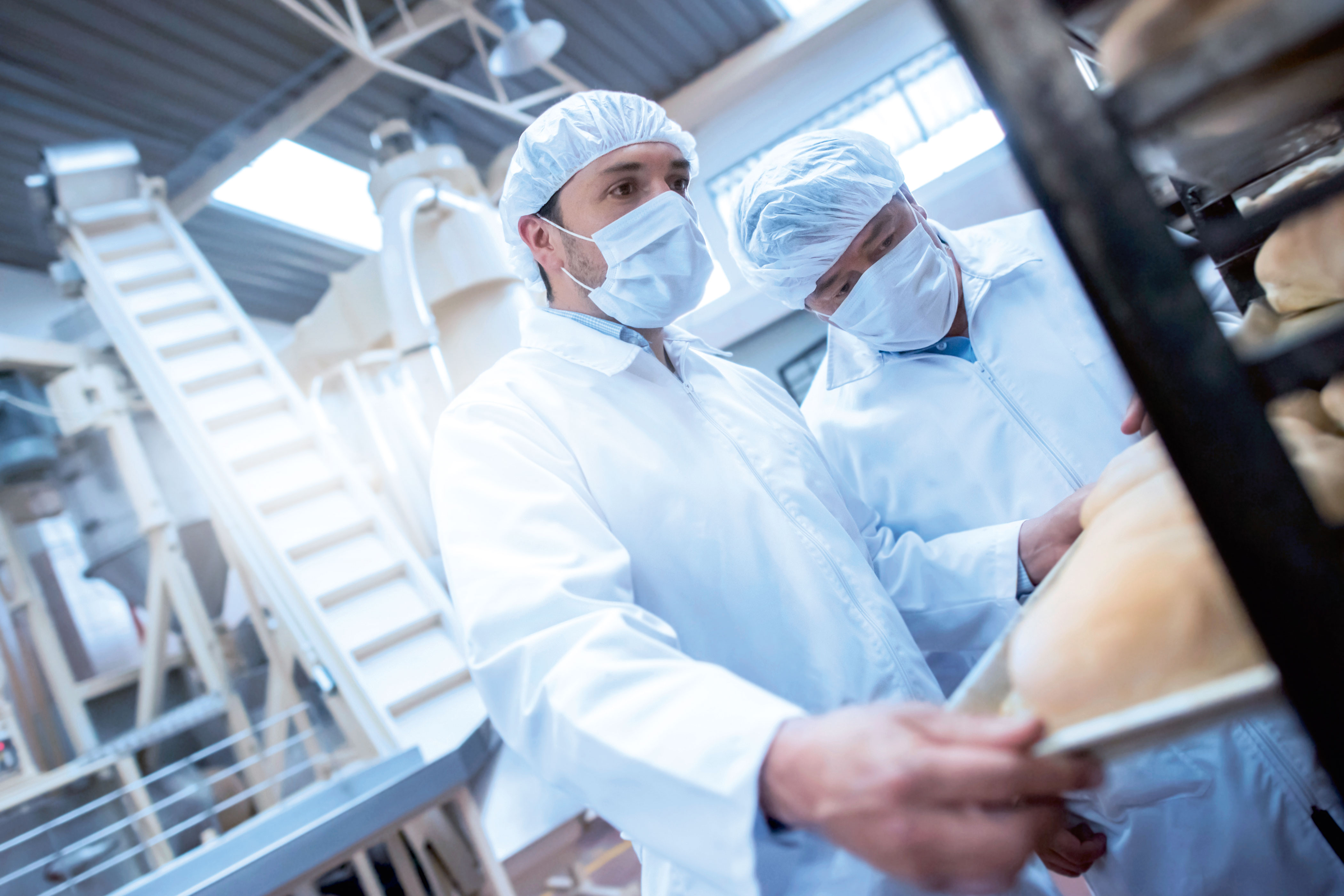
Food & Beverage industry
e.g. dairy products, meat processing industry, bakery products

Clinics and hospitals
e.g. in isolation rooms, operating rooms, treatment rooms, corridors

Public buildings
e.g. schools, universities, sports halls, department stores, concert halls, etc.

Public transport
e.g. in buses, trains, ships and aircrafts

Effective air filtration
protects food production processes from germs and viruses
Spreading of viruses in buildings
The risk of infection is particularly high in public buildings and hospitals, as there are many people in confined spaces that can be potentially infectious. Here viruses can, for example, be taken up and passed on via door handles (contact infection). Droplets containing viruses can also be present in the air and enter the human body via the air we breathe (droplet infection).
In addition to the familiar hygiene measures such as frequent hand washing, keeping your distance or wearing a mouth protection, suitable air filter systems can effectively reduce the risk of infection indoors. Perfectly matched filter stages separate almost all particles from the air and thus protect against airborne viruses. In addition, the level of fresh air should be increased as much as possible to further reduce the pathogen concentration in the room air. In ventilation systems with recirculation operation, HEPA filters or high-efficiency fine filters should be used for virus protection if they do not generate a differential pressure that is too high.
Air filters should be changed during normal maintenance intervals, i.e. when the pressure build-up or time restrictions make it necessary according to VDI 6022. Even in the current situation, air filters do not need to be changed more frequently or prematurely. When changing the filter, it is recommended to pack the removed filters airtight and dispose them at an incineration plant.
Reducing virus infection risks with micronAir cabin air filters
Effective protection for vehicle passengers through cabin air filters
Premium cabin air filters effectively reduce the infection risk of airborne viruses, thus offering reliable protection for vehicle passengers.
Spreading of viruses in vehicles
Viruses are capable of spreading inside vehicles as well. They reach vehicle interiors through infected people, for instance, and are spread when sneezing or coughing. Viruses remain infectious on surfaces such as the steering wheel, gear knob or seats for up to several days.
It is therefore particularly important to provide a sufficient amount of fresh air to the interior of vehicles in order to reduce the particle concentration and transport viruses out of the vehicle interior. Additionally, the ventilation system should include a high-efficient micronAir cabin air filter to effectively protect passengers against viruses. In the current global situation, cabin air filters should be changed more often than usual in order to continue to offer the highest filter performance and maximum virus protection.
 Language / Country
Language / Country


